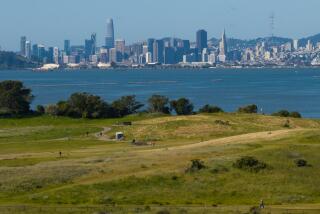Idea to ‘cage’ atomic plants is rejected
Federal regulators on Monday rejected requests from a California nuclear policy group to bolster security at atomic power plants, including protections against the type of air attack that destroyed the World Trade Center on Sept. 11.
The Nuclear Regulatory Commission turned down a formal petition from the Committee to Bridge the Gap, which contends that nuclear power stations remain vulnerable to terrorist air and ground assaults.
Commission officials said the precautions were unnecessary because research indicated reactors had “adequate protection” against airliners.
The nonprofit Committee to Bridge the Gap, based in Santa Cruz, proposed in 2004 that the Nuclear Regulatory Commission require atomic power plants to build giant steel cages around reactor buildings to deflect impacts from large commercial planes.
The group further asked the commission to increase to at least 19, from five, the number of attackers each nuclear power plant must be prepared to defend against. The request was based on the number of terrorists who hijacked airliners on Sept. 11.
The commission on Monday instead adopted regulations similar to security directives it imposed in April 2003, without public hearings, on operators of commercial reactors.
The directives deal with the size, training and composition of security forces; reactor security; barriers to protect against truck or car bombs; the dimensions of security perimeters; and the numbers of terrorists that plants must defend against. For national security, the specifics are confidential.
“We are taking a multifaceted approach to security enhancements in this post 9/11 threat environment and looking at how best to secure existing nuclear power plants,” said Nuclear Regulatory Commission Chairman Dale Klein.
The nation has about 100 commercial nuclear reactors, including four in California: two each at San Onofre in northern San Diego County and Diablo Canyon near San Luis Obispo. Many reactors are near major population centers.
Ray Golden, a spokesman for the San Onofre Nuclear Generating Station, said the station’s operator, Southern California Edison, had spent about $80 million on security improvements since Sept. 11, 2001.
He added that the plant was designed to withstand earthquakes and that thick concrete structures housed important systems.
Still, some fear that a terrorist attack could breach a reactor or a plant’s nuclear waste storage facilities and release harmful radiation.
“Rather than upgrading protections, the proposed rule merely codifies the status quo, reaffirming the existing, woefully inadequate security measures already in place at the nation’s reactors,” said Dan Hirsch, president of Committee to Bridge the Gap.
His organization’s call for fortifications was supported by attorneys general from eight states, including California, who said in letters to the commission that they were concerned that defenses were obsolete and might not be effective against large groups of heavily armed terrorists.
In November 2004, the commission agreed to consider the organization’s request and folded it into a formal public process to develop security regulations for the nuclear power industry.
In addition, the federal Energy Policy Act of 2005 asked the commission to upgrade security regulations and consider air assaults, attacks by large groups, and attacks of the magnitude of Sept. 11.
In rejecting the Committee to Bridge the Gap’s recommendations, the commission said that firefighting and evacuation procedures, strengthened after Sept. 11, were sufficient to deal with potential releases of radiation from fires and explosions.
Commissioners noted that such protections against air attack as fighter planes and anti-aircraft weapons were primarily the responsibility of the military and other federal organizations.
Consulting with law enforcement and intelligence agencies, commissioners interpreted Sept. 11 as four separate attacks, each involving four to five terrorists, and declined to increase the number of attackers that plants must be prepared to defend against.
Representatives of the nuclear power industry had opposed reactor cages as costly and unnecessary.
They said studies by the Nuclear Regulatory Commission and the Nuclear Energy Institute, a trade organization and lobbying arm for the industry, indicated that crashes of airliners into power plants were unlikely to cause significant harm to the public.
“We are comfortable that our nuclear power plants and spent fuel ponds are robust and can withstand significant impacts though they are not designed specifically for aircraft impacts,” said Tony Pietrangelo, vice president of regulatory affairs for the Nuclear Energy Institute.
In a German government study, however, researchers used flight simulators and computer analysis to show that airliners were able to hit nuclear reactors roughly half the time, occasionally triggering large fires and radiation release into the atmosphere.
“Fire prevention is always better than firefighting,” said Michele Boyd, an energy specialist with Public Citizen, a nonprofit Washington watchdog group. “Nuclear terrorism prevention is far more prudent than trying to reduce radiation exposures after the fact.”
*
More to Read
Sign up for Essential California
The most important California stories and recommendations in your inbox every morning.
You may occasionally receive promotional content from the Los Angeles Times.











